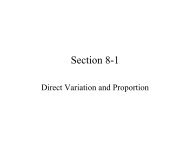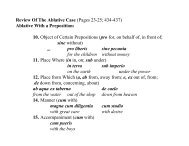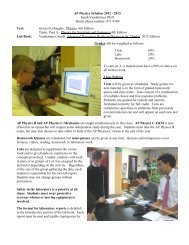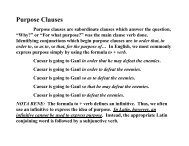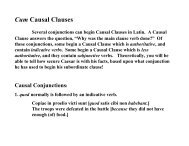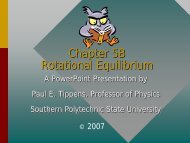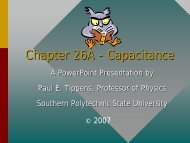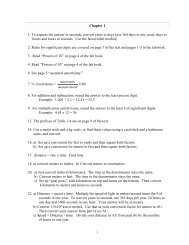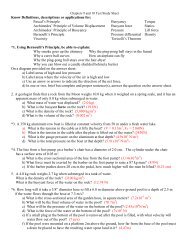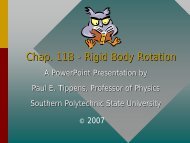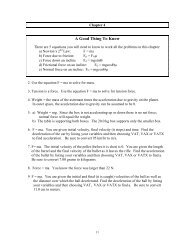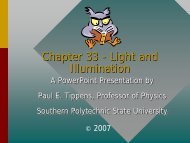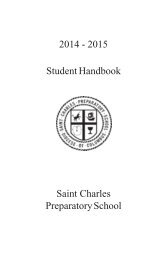Quantity of heat.pdf
Quantity of heat.pdf
Quantity of heat.pdf
Create successful ePaper yourself
Turn your PDF publications into a flip-book with our unique Google optimized e-Paper software.
Chapter 17. <strong>Quantity</strong> <strong>of</strong> Heat<br />
A PowerPoint Presentation by<br />
Paul E. Tippens, Pr<strong>of</strong>essor <strong>of</strong> Physics<br />
Southern Polytechnic State University<br />
© 2007
Photo © Vol. 05<br />
Photodisk/Getty<br />
FOUNDRY: It requires about 289 Joules <strong>of</strong> <strong>heat</strong> to<br />
melt one gram <strong>of</strong> steel. In this chapter, we will<br />
define the quantity <strong>of</strong> <strong>heat</strong> to raise the temperature<br />
and to change the phase <strong>of</strong> a substance.
Objectives: After finishing this<br />
unit, you should be able to:<br />
• Define the quantity <strong>of</strong> <strong>heat</strong> in terms <strong>of</strong> the calorie,<br />
the kilocalorie, the joule, and the Btu.<br />
• Write and apply formulas for specific<br />
<strong>heat</strong> capacity and solve for gains and<br />
losses <strong>of</strong> <strong>heat</strong>.<br />
• Write and apply formulas for<br />
calculating the latent <strong>heat</strong>s <strong>of</strong> fusion<br />
and vaporization <strong>of</strong> various materials.
Heat Defined as Energy<br />
Heat is is not something an object has, but rather<br />
energy that it it absorbs or or gives up. The <strong>heat</strong> lost by<br />
the hot coals is is equal to to that gained by the water.<br />
Cool<br />
water<br />
Thermal Equilibrium<br />
Hot coals
Units <strong>of</strong> Heat<br />
One calorie (1 cal) is the quantity <strong>of</strong> <strong>heat</strong> required<br />
to raise the temperature <strong>of</strong> 1 g <strong>of</strong> water by 1 C 0 .<br />
Example<br />
10 calories <strong>of</strong> <strong>heat</strong> will<br />
raise the temperature <strong>of</strong><br />
10 g <strong>of</strong> water by 10 C 0 .
Units <strong>of</strong> Heat (Cont.)<br />
One kilocalorie (1 kcal) is the quantity<br />
<strong>of</strong> <strong>heat</strong> required to raise the temperature<br />
<strong>of</strong> 1 kg <strong>of</strong> water by 1 C 0 .<br />
Example<br />
10 kilocalories <strong>of</strong> <strong>heat</strong> will<br />
raise the temperature <strong>of</strong> 10<br />
kg <strong>of</strong> water by 10 C 0 .
Units <strong>of</strong> Heat (Cont.)<br />
One British Thermal Unit (1 Btu) is the<br />
quantity <strong>of</strong> <strong>heat</strong> required to raise the<br />
temperature <strong>of</strong> 1 lb <strong>of</strong> water by 1 F 0 .<br />
Example<br />
10 Btu <strong>of</strong> <strong>heat</strong> will raise<br />
the temperature <strong>of</strong> 10 lb <strong>of</strong><br />
water by 10 F 0 .
The Btu is an Outdated Unit<br />
The British Thermal Unit (1 Btu) is discouraged, but<br />
unfortunately remains in wide-spread use today. If it<br />
is to be used, we must recognize that the pound unit<br />
is actually a unit <strong>of</strong> mass, not weight.<br />
1 lb<br />
1 lb (1/32) slug<br />
When working with the Btu, we must<br />
recall that the pound-mass<br />
is not a<br />
variable quantity that depends on<br />
gravity --<br />
one reason that the use <strong>of</strong><br />
the Btu is discouraged!
The SI Unit <strong>of</strong> Heat<br />
Since <strong>heat</strong> is is energy, the joule is is the preferred<br />
unit. Then, mechanical energy and <strong>heat</strong> are<br />
measured in in the same fundamental unit.<br />
Comparisons <strong>of</strong> Heat Units:<br />
1 cal = 4.186 J<br />
1 Btu = 778 ft ft lb lb<br />
1 kcal = 4186 J<br />
1 Btu = 252 cal<br />
1 Btu = 1055 J
Temperature and <strong>Quantity</strong> <strong>of</strong> Heat<br />
The effect <strong>of</strong> <strong>heat</strong> on temperature<br />
depends on the<br />
quantity <strong>of</strong> matter <strong>heat</strong>ed.<br />
The same quantity <strong>of</strong> <strong>heat</strong><br />
is applied to each mass <strong>of</strong><br />
water in the figure.<br />
The larger mass<br />
experiences a smaller<br />
increase in temperature.<br />
20 0 C<br />
600 g<br />
20 0 C<br />
200 g<br />
22 0 C<br />
30 0 C
Heat Capacity<br />
The <strong>heat</strong> capacity <strong>of</strong> a substance is the <strong>heat</strong><br />
required to raise the temperature a unit degree.<br />
Lead Glass Al Copper Iron<br />
100 0 C 100 0 C 100 0 C 100 0 C 100 0 C<br />
37 s 52 s 60 s 83 s 90 s<br />
Heat capacities based on time to <strong>heat</strong> from zero<br />
to 100 0 C. Which has the greatest <strong>heat</strong> capacity
Heat Capacity (Continued)<br />
All at at 100 0 C placed on Paraffin Slab<br />
Lead Glass Al Copper Iron<br />
Iron and copper balls melt all the way through;<br />
others have lesser <strong>heat</strong> capacities.
Specific Heat Capacity<br />
The specific <strong>heat</strong> capacity <strong>of</strong> <strong>of</strong> a material is is the<br />
quantity <strong>of</strong> <strong>of</strong> <strong>heat</strong> needed to to raise the<br />
temperature <strong>of</strong> <strong>of</strong> a unit mass through a unit<br />
degree.<br />
Q<br />
c ; Q mct<br />
mt<br />
Water: c = 1.0 cal/g C 0 or or 1 Btu/lb F 0 or or 4186 J/kg K<br />
Copper: c = 0.094 cal/g C 0 or or 390 J/kg K
Comparison <strong>of</strong> Heat Units: How much <strong>heat</strong> is<br />
needed to raise 1-kg 1<br />
<strong>of</strong> water from 0 0 to 100 0 C<br />
The mass <strong>of</strong> one kg <strong>of</strong> water is:<br />
1 kg = 1000 g = 0.454 lb m<br />
Qmct<br />
1 lb m = 454 g<br />
1 kg<br />
For water: c = 1.0 cal/g C 0<br />
or 1 Btu/lb F 0 or 4186 J/kg K<br />
The <strong>heat</strong> required to do this job is:<br />
10,000 cal 10 kcal<br />
39.7 Btu 41, 860 J
Problem Solving Procedure<br />
1. Read problem carefully and draw a rough sketch.<br />
2. Make a list <strong>of</strong> all given quantities<br />
3. Determine what is to be found.<br />
4. Recall applicable law or formula and constants.<br />
Q<br />
c ; Qmct<br />
mt<br />
Water: c = 1.0 1.0 cal/g C 00 or or 1 Btu/lb F 00 or or 4186 J/kg K<br />
5. Determine what was to be found.
Example 1: A 500-g copper c<strong>of</strong>fee mug<br />
is filled with 200-g <strong>of</strong> c<strong>of</strong>fee. How much<br />
<strong>heat</strong> was required to <strong>heat</strong> cup and<br />
c<strong>of</strong>fee from 20 to 96 0 C<br />
1. Draw sketch <strong>of</strong> problem.<br />
2. List given information.<br />
Mug mass m m = 0.500 kg<br />
C<strong>of</strong>fee mass m c = 0.200 kg<br />
Initial temperature <strong>of</strong> c<strong>of</strong>fee and mug: t 0 = 20 0 C<br />
Final temperature <strong>of</strong> c<strong>of</strong>fee and mug: t f = 96 0 C<br />
3. List what is to be found:<br />
Total <strong>heat</strong> to raise temperature<br />
<strong>of</strong> c<strong>of</strong>fee (water) and mug to 96 0 C.
Example 1(Cont.): How much <strong>heat</strong> needed to<br />
<strong>heat</strong> cup and c<strong>of</strong>fee from 20 to 96 0 C<br />
m m = 0.2 kg; ; m w = 0.5 kg.<br />
4. Recall applicable formula or law:<br />
Heat Gain or Loss:<br />
Q = mc t<br />
5. Decide that TOTAL <strong>heat</strong> is that<br />
required to raise temperature <strong>of</strong> mug<br />
and water (c<strong>of</strong>fee). Write equation.<br />
Q T = m m c m t + m w c w t<br />
6. Look up specific<br />
<strong>heat</strong>s in tables:<br />
Copper: c m = 390 J/kg C 0<br />
C<strong>of</strong>fee (water): c w = 4186 J/kg C 0
Example 1(Cont.): How much <strong>heat</strong> needed<br />
to <strong>heat</strong> cup and c<strong>of</strong>fee from 20 to 96 0 C<br />
m c = 0.2 kg; ; m w = 0.5 kg.<br />
7. Substitute info and solve problem:<br />
Copper: c m = 390 J/kg C 0<br />
C<strong>of</strong>fee (water): c w = 4186 J/kg C 0<br />
Q T =m m c m t+ m w c w t<br />
Water: (0.20 kg)(4186 J/kgC 0 )(76 C 0 )<br />
Cup: (0.50 kg)(390 J/kgC 0 )(76 C 0 )<br />
t = 96 0 C - 20 0 C<br />
= 76 C 0<br />
Q T = 63,600 J + 14,800 J<br />
Q T = 78.4 kJ kJ
A Word About Units<br />
The substituted units must be consistent with those <strong>of</strong><br />
the chosen value <strong>of</strong> specific <strong>heat</strong> capacity.<br />
For example: Water c w = 4186 J/kg C 0 or 1 cal/g C 0<br />
Q = m w c w t<br />
If If The you units use 4186 1 for cal/g Q, J/kg Cm, 0 Cfor and 0 for c,<br />
c, t c, c,<br />
then must Q be must consistent be in in calories, joules, with<br />
and<br />
m and those must m must based be in in be kilograms. on in in the value <strong>of</strong><br />
the constant c.
Conservation <strong>of</strong> Energy<br />
Whenever there is a transfer <strong>of</strong> <strong>heat</strong> within a<br />
system, the <strong>heat</strong> lost by the warmer bodies must<br />
equal the <strong>heat</strong> gained by the cooler bodies:<br />
(Heat Losses) = (Heat Gained)<br />
Hot<br />
iron<br />
Cool<br />
water<br />
Thermal Equilibrium
Example 2: A handful <strong>of</strong> copper<br />
shot is <strong>heat</strong>ed to 90 0 C and then<br />
dropped into 80 g <strong>of</strong> water in an<br />
insulated cup at 10 0 C. . If the<br />
equilibrium temperature is 18 0 C,<br />
what was the mass <strong>of</strong> the copper<br />
c w = 4186 J/kg C 0 ; c s = 390 J/kg C 0<br />
90 0 shot<br />
Insulator<br />
t e = 18 0 C<br />
10 0<br />
water<br />
m w = 80 g; t w = 10 0 C; t s = 90 0 C<br />
Heat lost by shot = <strong>heat</strong> gained by water<br />
m s c s (90 0 C - 18 0 C) = m w c w (18 0 C - 10 0 C)<br />
Note: Temperature differences are [High - Low] to<br />
insure absolute values (+) lost and gained.
m s = <br />
90 0 shot<br />
Insulator<br />
Example 2: (Cont.)<br />
10 0<br />
water<br />
18 0 C<br />
80 g <strong>of</strong> Water<br />
Heat lost by shot = <strong>heat</strong> gained by water<br />
m s c s (90 0 C - 18 0 C) = m w c w (18 0 C - 10 0 C)<br />
m s (390 J/kgC 0 )(72 C 0 ) = (0.080 kg)(4186 J/kgC 0 )(8 C 0 )<br />
2679 J<br />
ms<br />
0.0954 kg m s<br />
28,080 J/kg<br />
s<br />
= 95.4 g
Change <strong>of</strong> Phase<br />
When a change <strong>of</strong> <strong>of</strong> phase occurs, there is is only a<br />
change in in potential energy <strong>of</strong> <strong>of</strong> the molecules. The<br />
temperature is is constant during the change.<br />
Solid<br />
fusion<br />
Liquid<br />
Vaporization<br />
Gas<br />
Q = mL f<br />
Q = mL v<br />
Terms: Fusion, vaporization, condensation, latent<br />
<strong>heat</strong>s, evaporation, freezing point, melting point.
Change <strong>of</strong> Phase<br />
The latent <strong>heat</strong> <strong>of</strong> fusion (L f ) <strong>of</strong> a substance is<br />
the <strong>heat</strong> per unit mass required to change the<br />
substance from the solid to the liquid phase <strong>of</strong><br />
its melting temperature.<br />
For Water: L f f<br />
= 80 80 cal/g = 333,000 J/kg<br />
L<br />
f<br />
<br />
Q<br />
m<br />
The latent <strong>heat</strong> <strong>of</strong> vaporization (L v ) <strong>of</strong> a<br />
substance is the <strong>heat</strong> per unit mass required<br />
to change the substance from a liquid to a<br />
vapor at its boiling temperature.<br />
L<br />
v<br />
<br />
Q<br />
m<br />
For Water: L v v<br />
= 540 cal/g = 2,256,000 J/kg
Melting a Cube <strong>of</strong> Copper<br />
The <strong>heat</strong> Q required to melt a<br />
substance at its melting temperature<br />
can be found if the mass and latent<br />
<strong>heat</strong> <strong>of</strong> fusion are known.<br />
2 kg<br />
What Q<br />
to melt<br />
copper<br />
Q = mL vv<br />
L f = 134 kJ/kg<br />
Example: To completely melt<br />
2 kg <strong>of</strong> copper at 1040 0 C, we need:<br />
Q = mL f = (2 kg)(134,000 J/kg) Q = 268 kJ kJ
Example 3: How much <strong>heat</strong> is needed to<br />
convert 10 g <strong>of</strong> ice at -20<br />
0 C to steam at 100 0 C<br />
First, let’s review the process graphically as shown:<br />
temperature<br />
t<br />
ice steam 540 cal/g<br />
100 0 C<br />
0 0 C<br />
-20 0 C<br />
1 cal/gC 0<br />
80 cal/g<br />
water<br />
ice c ice<br />
and = 0.5 cal/gC only<br />
0<br />
ice water<br />
steam<br />
and<br />
water<br />
steam<br />
only<br />
Q
Example 3 (Cont.): Step one is Q 1 to convert<br />
10 g <strong>of</strong> ice at -20<br />
0 C to ice at 0 0 C (no water yet).<br />
-20 0 C 0 0 C<br />
t<br />
100 0 C<br />
Q 1 to raise ice to 0 0 C: Q 1 = mct<br />
Q 1 = (10 g)(0.5 cal/gC 0 )[0 - (-20 0 C)]<br />
Q 1 = (10 g)(0.5 cal/gC 0 )(20 C 0 )<br />
0 0 C<br />
-20 0 C<br />
ice<br />
c ice = 0.5 cal/gC 0<br />
Q 1 = 100 cal<br />
Q
Example 3 (Cont.): Step two is Q 2 to convert<br />
10 g <strong>of</strong> ice at 0 0 C to water at 0 0 C.<br />
Melting<br />
t<br />
100 0 C<br />
Q 2 to melt 10 g <strong>of</strong> ice at 0 0 C: Q 2 = mL f<br />
Q 2 = (10 g)(80 cal/g) = 800 cal<br />
Q 2 = 800 cal<br />
0 0 C<br />
-20 0 C<br />
80 cal/g<br />
ice and<br />
water<br />
Add this to Q 1 = 100 cal:<br />
900 cal used to this point.<br />
Q
Example 3 (Cont.): Step three is Q 3 to change<br />
10 g <strong>of</strong> water at 0 0 C to water at 100 0 C.<br />
0 0 C to 100 0 C<br />
t<br />
100 0 C<br />
Q 3 to raise water at 0 0 C to 100 0 C.<br />
Q 3 = mct ; c w = 1 cal/gC 0<br />
Q 3 = (10 g)(1 cal/gC 0 )(100 0 C - 0 0 C)<br />
1 cal/gC 0<br />
Q 3 = 1000 cal<br />
0 0 C<br />
-20 0 C<br />
water<br />
only<br />
Total = Q 1 + Q 2 + Q 3<br />
= 100 +900 + 1000<br />
= 1900 cal<br />
Q
Example 3 (Cont.): Step four is Q 4 to convert<br />
10 g <strong>of</strong> water to steam at 100 0 C ( (Q 4 = mL v )<br />
vaporization<br />
Q 4 to convert all water at 100 0 C<br />
to steam at 100 0 C. (Q = mL v )<br />
100 0 C<br />
Q 4 = (10 g)(540 cal/g) = 5400 cal<br />
0 0 C<br />
-20 0 C<br />
800 cal<br />
100 cal<br />
ice<br />
ice and<br />
water<br />
1000<br />
cal<br />
water<br />
only<br />
5400 cal Total Heat:<br />
steam<br />
and<br />
water<br />
7300 cal<br />
Q
Example 4: How many grams <strong>of</strong> ice at 0 0 C<br />
must be mixed with four grams <strong>of</strong> steam in<br />
order to produce water at 60 0 C<br />
m i = <br />
Ice must melt and then rise to 60 0 C.<br />
Steam must condense and drop to 60 0 ice<br />
C.<br />
steam<br />
Total Heat Gained = Total Heat Lost<br />
4 g<br />
m i L f + m i c w t= m s L v + m s c w t<br />
t e = 60 0 C<br />
Note: All losses and gains are absolute values (positive).<br />
Total Gained: m i i -0 0 i (80 cal/g) + m i (1 cal/gC 0 )(60 C 0 ) C)<br />
Total Lost: Lost: (4 g)(540 (4 g)(540 cal/g) cal/g) + (4 g)(1 + (4 cal/gC g)(1 cal/gC 0 )(100 0 )(40 C 0 -60 C 00 ) C)
Example 4 (Continued)<br />
Total Gained: m i (80 cal/g) + m i (1 cal/gC 0 )(60 C 0 )<br />
Total Lost: (4 g)(540 cal/g) + (4 g)(1 cal/gC 0 )(40 C 0 )<br />
Total Heat Gained = Total Heat Lost<br />
80m i + 60m i = 2160 g +160 g<br />
m i = <br />
4 g<br />
mi<br />
<br />
2320 g<br />
140<br />
m i i<br />
= 16.6 g<br />
t e = 60 0 C
Example 5: Fifty grams <strong>of</strong> ice<br />
are mixed with 200 g <strong>of</strong> water<br />
initially at 70 0 C. . Find the<br />
equilibrium temperature <strong>of</strong> the<br />
mixture.<br />
Ice melts and rises to t e<br />
Water drops from 70 to t e .<br />
ice water<br />
0 0 C 70 0 C<br />
50 g 200 g<br />
t e = <br />
Heat Gained: m i L f + m i c w t ; t = t e -0 0 C<br />
Gain = (50 g)(80 cal/g) + (50 g)(1 cal/gC 0 )(t e -0 0 C)<br />
Gain = 4000 cal + (50 cal/g)t e
Example 5 (Cont.):<br />
Gain = 4000 cal + (50 cal/g)t e<br />
Heat Lost = m w c w t<br />
t = 70 0 C -t e<br />
[high - low]<br />
0 0 C 70 0 C<br />
50 g 200 g<br />
t e = <br />
Lost = (200 g)(1 cal/gC 0 )(70 0 C- t e )<br />
Lost = 14,000 cal - (200 cal/C 0 ) t e<br />
Heat Gained Must Equal the Heat Lost:<br />
4000 cal + (50 cal/g)t e = 14,000 cal - (200 cal/C 0 ) t e
Example 5 (Cont.):<br />
Heat Gained Must Equal the Heat Lost:<br />
4000 cal + (50 cal/g)t e = 14,000 cal - (200 cal/C 0 ) t e<br />
Simplifying, we have: (250 cal/C 0 ) t e = 10,000 cal<br />
t <br />
e<br />
10,000 cal<br />
250 cal/C<br />
0<br />
0<br />
40 C<br />
0 0 C 70 0 C<br />
50 g 200 g<br />
tt e e = 40 0 C<br />
t e =
Summary <strong>of</strong> Heat Units<br />
One calorie (1 cal) is the quantity <strong>of</strong> <strong>heat</strong><br />
required to raise the temperature <strong>of</strong> 1 g <strong>of</strong><br />
water by 1 C 0 .<br />
One kilocalorie (1 kcal) is the quantity <strong>of</strong> <strong>heat</strong><br />
required to raise the temperature <strong>of</strong> 1 kg <strong>of</strong><br />
water by 1 C 0 .<br />
One British thermal unit (Btu) is the quantity<br />
<strong>of</strong> <strong>heat</strong> required to raise the temperature <strong>of</strong> 1<br />
lb <strong>of</strong> water by 1 F 0 .
Summary: Change <strong>of</strong> Phase<br />
The latent <strong>heat</strong> <strong>of</strong> fusion (L f ) <strong>of</strong> a substance is<br />
the <strong>heat</strong> per unit mass required to change the<br />
substance from the solid to the liquid phase <strong>of</strong><br />
its melting temperature.<br />
For Water: L f f<br />
= 80 80 cal/g = 333,000 J/kg<br />
L<br />
f<br />
<br />
Q<br />
m<br />
The latent <strong>heat</strong> <strong>of</strong> vaporization (L v ) <strong>of</strong> a<br />
substance is the <strong>heat</strong> per unit mass required<br />
to change the substance from a liquid to a<br />
vapor at its boiling temperature.<br />
L<br />
v<br />
<br />
Q<br />
m<br />
For Water: L v v<br />
= 540 cal/g = 2,256,000 J/kg
Summary: Specific Heat Capacity<br />
The specific <strong>heat</strong> capacity <strong>of</strong> <strong>of</strong> a<br />
material is is the quantity <strong>of</strong> <strong>of</strong> <strong>heat</strong> to to<br />
raise the temperature <strong>of</strong> <strong>of</strong> a unit<br />
mass through a unit degree.<br />
Q<br />
c ; Q mct<br />
mt
Summary: Conservation <strong>of</strong> Energy<br />
Whenever there is a transfer <strong>of</strong> <strong>heat</strong><br />
within a system, the <strong>heat</strong> lost by the<br />
warmer bodies must equal the <strong>heat</strong><br />
gained by the cooler bodies:<br />
(Heat Losses) = (Heat Gained)
Summary <strong>of</strong> Formulas:<br />
Q<br />
c ; Q mct<br />
mt<br />
(Heat Losses) = (Heat Gained)<br />
Q<br />
Lf<br />
; Q mL<br />
m<br />
Q<br />
Lv<br />
; Q mL<br />
m<br />
f<br />
v
CONCLUSION: Chapter 17<br />
<strong>Quantity</strong> <strong>of</strong> Heat




